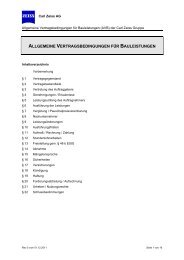Download PDF - Carl Zeiss
Download PDF - Carl Zeiss
Download PDF - Carl Zeiss
Create successful ePaper yourself
Turn your PDF publications into a flip-book with our unique Google optimized e-Paper software.
Johannes Kepler (1571-1630)<br />
Natural philosopher, mathematician,<br />
astronomer, astrologist and optician.<br />
He discovered the laws of planetary motion<br />
– Kepler’s Laws. In mathematics, the<br />
approximate calculation of numerical<br />
integrals was named after him (Kepler’s<br />
Fassregel). With his Dioptrice published<br />
in 1611, Kepler laid the foundations<br />
for optics as a science.<br />
reconcile the geo- and heliocentric<br />
views. His pupil and assistant,<br />
Johannes Kepler, completed Brahe’s<br />
work following his death. Kepler’s<br />
orbital mechanics, which has the<br />
planets move on elliptical orbits<br />
around the sun, continues to be valid<br />
to this day. Dominican friar Giordano<br />
Bruno (1548-1600) explained the<br />
cosmos to be infinite and the sun to<br />
be its center: he even claimed that<br />
there is an infinite number of worlds,<br />
each with its own sun. Galileo Galilei<br />
built a copy of the telescope of<br />
Lippershey and was probably the first<br />
to use it for celestial observations.<br />
He discovered mountains on the<br />
moon, the four moons of Jupiter,<br />
sunspots (at the same time as others),<br />
the rings of Saturn and the<br />
change in the phases of Venus.<br />
Galileo was a fervent proponent of<br />
Copernican teachings which earned<br />
him a summons to the court of inquisition<br />
in 1616 and a warning<br />
not to spread the “false” teachings<br />
of Copernicus. Ultimately, he was<br />
forced to renounce the Copernican<br />
views in 1633.<br />
Innovation 16, <strong>Carl</strong> <strong>Zeiss</strong> AG, 2005<br />
special<br />
Egyptian calendar<br />
The Egyptian calendar was probably invented in the<br />
29 th century B.C.: it consists of three annual seasons<br />
of four 30-day months.<br />
Adding five epagomenal days representing the birthdays<br />
of the gods, Osiris, Horus, Seth, Isis and Nephthys,<br />
the Egyptian calendar had a total of 365 days.<br />
The earliest astronomical image of the northern and<br />
southern hemisphere in the grave of Senen-mut.<br />
The southern hemisphere – top – shows a list of the<br />
decans (stars) including the constellations of the<br />
southern sky, Orion and Sothis (Sopdet). Moreover,<br />
the planets Jupiter, Saturn, Mercury, and Venus are<br />
shown, some of them as gods crossing the sky<br />
in row boats.<br />
The northern hemisphere – bottom – shows constellations<br />
of the northern sky including the Great Bear<br />
(Ursa major) in the middle.<br />
The remaining constellations have not been identified.<br />
To the right and left, there are 8 and 4 circles,<br />
respectively, below which a number of gods carrying<br />
sun discs strides towards the middle of the picture.<br />
The inscriptions on the circles correspond to the<br />
original monthly festivities in the lunar calendar,<br />
the inscriptions of the gods denote the original days<br />
of the lunar calendar.<br />
17
















